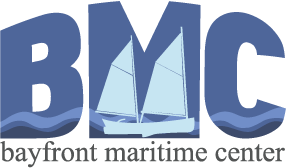Right now, you can see daylight through the bottom of Porcupine’s fiberglass keel in 14 different places. In some spots, you can see right up through the deck hatches. Normally, this is nothing to celebrate in a vessel of any sort. But in an out of the box project like ours, it marks a clear sign of progress for Team Porcupine, because these holes, all 1-1/4”, clear the way for attaching the ballast keel.
The entire process of transforming our Bruce Roberts Spray 40 into Porcupine will be a series of puzzles. As our first one, the keel has proved tricky. Attaching a steel structure

Nick Rinn drilling the keel bolt holes. The process is water-cooled to help keep the hole saw from wearing out.
to the bottom of an existing fiberglass hull that was never intended to have external ballast has required a juggling of design, function, and practicality. Fortunately, our team is pretty nimble in the realm of nautical acrobatics.
Thanks to the plasma cutting table at Gene Davis Sales, our keel is on site, with “some assembly required.” This means we got nearly two dozen precision cut plates and tubes and are drilling, bending, and welding them to create the structure, ballast chambers, and, of course, sleeves for the bolts to attach the keel. As we approach this major step in Porcupine’s transformation, the holes in the keel are the light at the start of our tunnel.
All best,
Jamie Trost and Team Porcupine.


so Jamie, this is a question and a comment: do I understand that the keel is (steel?) plates sandwiched in fiberglass? and what are the dimensions of it? and here’s the comment: this all seems pretty cool!!
Hello Bob,
It’s not a sandwich! The hull is fiberglass, the keel is steel. So we’re attaching a steel box, filled in some places with other steel as ballast, to the bottom of the fiberglass hull. There may be some fairing of the union with epoxy or the like, but the keel’s surface won’t be glassed in, just painted.
Thanks, Jamie….sounds like it’s gonna be a great boat…it’s fun watching it come together….i’d like to stop in and see it when I’m up that way, which isn’t very often….bob